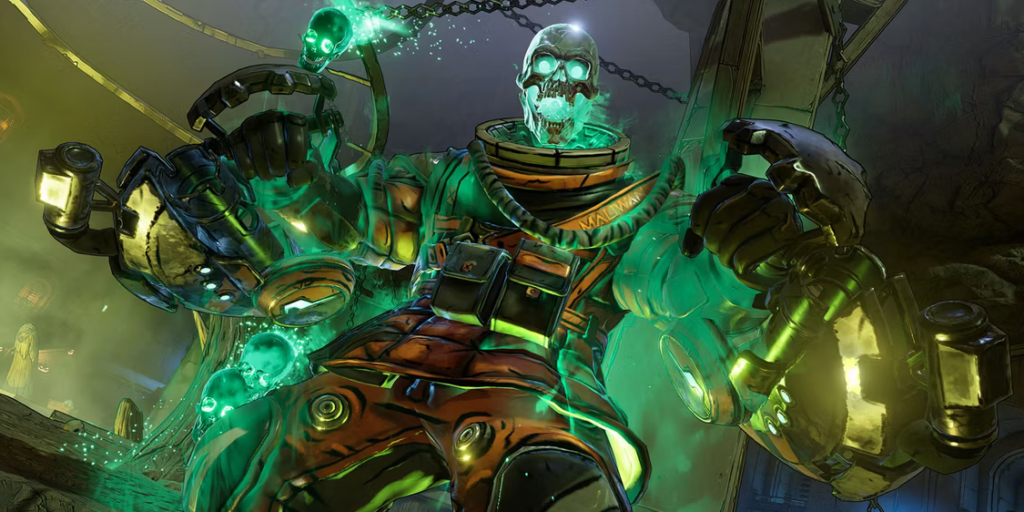
This design deep dive is a collaboration between Tom Hammond, CEO at UserWise which is company providing live-ops tools, Eva Grillova, Senior Game Designer at Socialpoint and my long time deconstruction partner, and me (Manyu).
Also big thank yous to MTM’s very own Owen Soh and Aaron for their support throughout the writing process.
Every once in a while, there comes a game that marks the start of an inflection point in mobile games. Major tectonic shifts were felt with the launches of Angry Birds, Candy Crush, Clash of Clans and Clash Royale, to name a few. More recently and in 2019, it was Archero, which marked the beginnings of the Hybridcasual movement. The game took the market by storm, found growth opportunities in the current market, and opened the industry’s eyes to a new world of possibilities. In 2020, there is one game that holds similar characteristics - Genshin Impact.
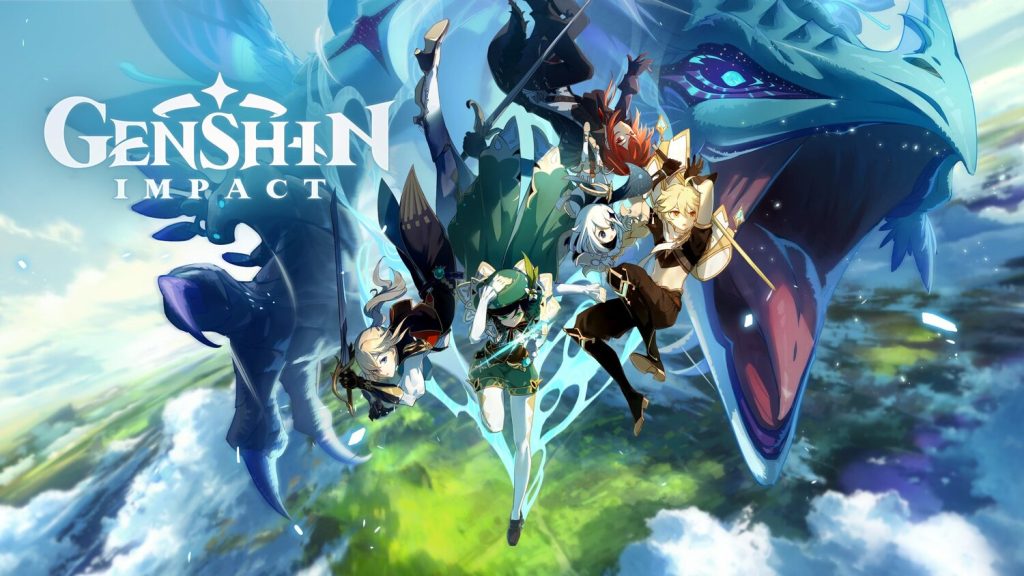
Genshin Impact (GI) is developed by miHoYo - a Shanghai-based studio best known for producing high quality F2P mobile titles like Honkai Impact 3rd (HI3), which is the company’s most successful game to date. GI rivals top console titles with an estimated $100M development + marketing budget, a 4 year production timeline and over 300 people working on it. It is available across PC, PS4, and mobile, enables cross-play, and a Nintendo Switch version is in the works.
With that level of investment, GI leaves a strong first impression across platforms. It is stunningly beautiful, content rich, highly engaging and aurally pleasing, which isn’t surprising, considering the soundtrack was recorded by the Shanghai Symphony Orchestra and the London Philharmonic Orchestra, who also did the music for the Lord of the Rings trilogy. Overall, the game experience truly feels like playing a full-fledged console title on your mobile phone, except it is free to play.
On its September 28th 2020 launch, GI made headlines across the industry. Not only did it break international launch records for a China-developed game, but it also grossed more than China’s TikTok on launch day and captured more Twitch viewership than Fortnite at the same time. Two month’s hence and according to Sensor Tower, GI has brought in ~$400M in revenue on mobile, thereby averaging $6M a day and has broken into the top 50 highest grossing mobile games in history! Add in additional revenues from PS4 and PC, and the game is strongly ROI positive for miHoYo and seems like it is on track to be a billion dollar game. For comparison, HI3 has grossed ~$500M over 5 years, therefore making GI’s monthly revenue rate 24x that of HI3’s - not many studios can say that about a successive title launch. Finally, in terms of critical acclaim, GI has a Metacritic score of above 80, won Apple’s "iPhone Game of the Year 2020" award, and also won Google’s "Best Game of 2020" award.
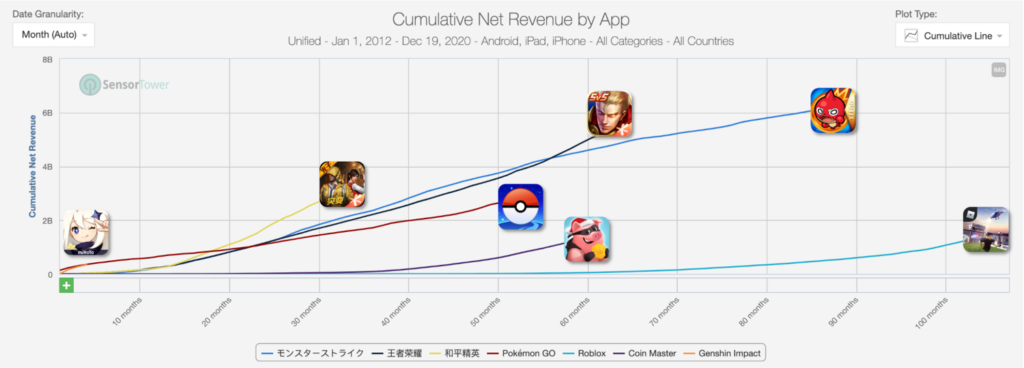
With all this context, there is no question that the game is a huge success for miHoYo. But the question still remains - why does GI mark an inflection point for mobile games? The short answer is - GI has set a precedent by opening the eyes of developers across the world to a new level of gaming experience that is possible to create for mobile audiences. The long answer - well, it starts with understanding the beginnings of the company behind the game.
miHoYo’s Otakus and their Audacious Vision
The why of miHoYo is most succinctly captured in the company’s mission statement - “Tech Otakus Save The World”. And the way we see it, it is the “Otakus” using “Tech” to “Save The World”. Here is what that really means.
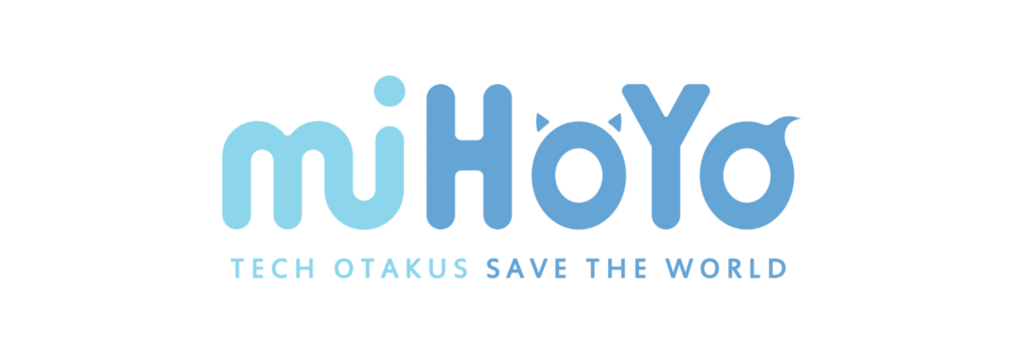
“Otaku” is a Japanese term for people with consuming interests, particularly fixed in the Japanese ACG (Anime, Comics and Games) culture. miHoYo was founded in 2011 by three students, Cai Haoyu, Liu Wei and Luo Yuhao, of the Shanghai Jiao Tong University. All three identified themselves as Otakus. The founding trio also all had backgrounds in computer science engineering, which is where the “Tech” comes in. And how did they plan to “Save The World”? The answer to that is of course obvious. Read more about the beginnings of miHoYo here.

Since inception, miHoYo’s vision has unwaveringly been twofold. First, they hope to create ACG moe games, in which players develop strong emotions and connections with the characters and their stories. Second, miHoYo wants to push the boundaries of their creations from a technology perspective. In other words, that means creating technical marvels through their games. Both elements of their vision can be clearly seen in the image below that captures how all their titles have strongly maintained a strong ACG thematic, while technical fidelity and resulting production value has improved with every successive title.

It was only after understanding this background that GI’s existence, scale and vision started to make more sense to us, and it is clearly rooted in everything that miHoYo has always been about. To peel back a few more layers, the audacious vision for GI can be broken into four key components.
#1: Pushing miHoYo’s Technological Vision to New Heights
While GI might be the first game that most people have heard of from miHoYo, it is definitely not miHoYo’s first. They have been pushing out games of increasing size and complexity since they began in 2011 as an indie studio.
Their first game “FlyMe2TheMoon” launched in 2011 and was an unusual side scroller with miHoYo’s signature ACG theming. It was followed by “Zombiegirl Kawaii” in 2012, which inherited the ACG theming and side scrolling aspects from their first title, but added complexity in terms of control systems and gameplay fidelity. Then came their first hit “Guns GirlZ” in 2014, which again maintained the ACG theming, inherited the control systems and gameplay fidelity from “Zombiegirl Kawaii”, but experimented with a different genre and for the first time explored deep RPG progression mechanics.
Therefore, over their first 3-5 years of launching and operating free-to-play mobile games, miHoYo honed in on perfecting their grasp of ACG art style and theming, action RPG control systems, designing and balancing deep RPG progression mechanics, and increasing production qualities and technical complexity with every successive title.
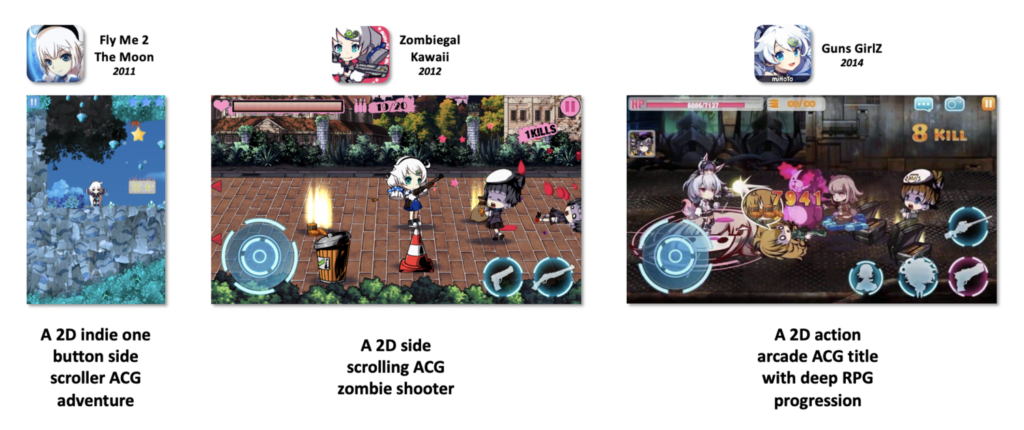
This slow and steady building up of skills and knowledge resulted in miHoYo’s first true technical, gameplay and business marvel in 2016, “Honkai Impact 3rd”. For anyone who has been playing miHoYo’s games since 2011, it is quite clear that HI3 is the culmination of all of miHoYo’s previously learnt mobile free-to-play design, artistic and production knowledge. But where HI3 truly differentiates itself from miHoYo’s past portfolio and all other action RPG’s on the market is its insanely high production quality, which is built on top of a very solid technical foundation that truly pushes the mobile platform to its limits. To put this in context, HI3’s playing community has nicknamed the game as the “phone killer”!
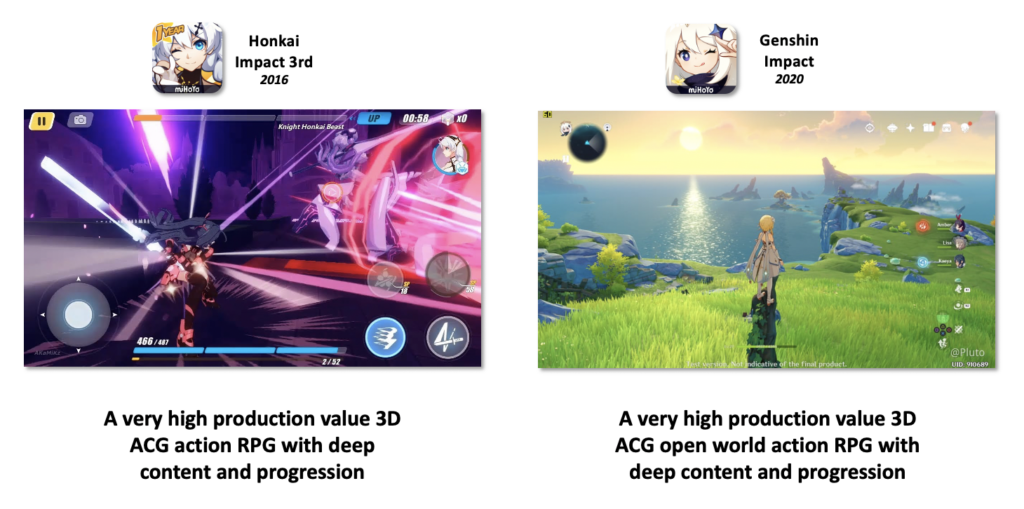
When laying out all of miHoYo’s titles on such a timeline and singling out their distinctive features, it becomes quite clear that the company always tries to strive for achieving something bold and new with every successful title, while making sure to reinvest learnings into future titles. Therefore, following the successful release of HI3, one could hypothesise that miHoYo was left wondering - what can we do next that could be bigger and more challenging than HI3? How about a cross-platform, triple AAA quality, persistent open world game?
Discover & share this Mic GIF with everyone you know. GIPHY is how you search, share, discover, and create GIFs.
#2: Delivering a Console Experience across Platforms
As mentioned before, GI is available across both mobile and console platforms. While the console version of course looks great, the mobile version looks equally good! And quite frankly, while there are many high production value games on mobile, GI’s mobile experience is arguably the best of the lot.
Pulling off such a high quality of graphical fidelity and doing so consistently across all platforms is not easy, and there is definitely a lot of technical wizardry at play behind the scenes, which is audacious in itself. At Unity’s Online Technological Conference on November 17th 2020, GI’s technical director Yi Zhenzhong also mentioned, and this is translated - “… we have a Unity engine that has been extensively developed for mobile phones, which means that "simply switching platforms to make the game run on PS4" is impossible …”.
Keep in mind, this is miHoYo’s first cross-platform game. Further, it is also their first persistent open world game. That basically meant that miHoYo had to build from scratch a team, the skills, and a lot of technical foundation to allow for a high quality experience across platforms. While getting into all the technical miracles to make this game possible is out of the scope of this essay, you can read more here. What stood out to us, however, is miHoYo’s aim for the development team to push technical boundaries - “if art wants it, we find a way to do it”.
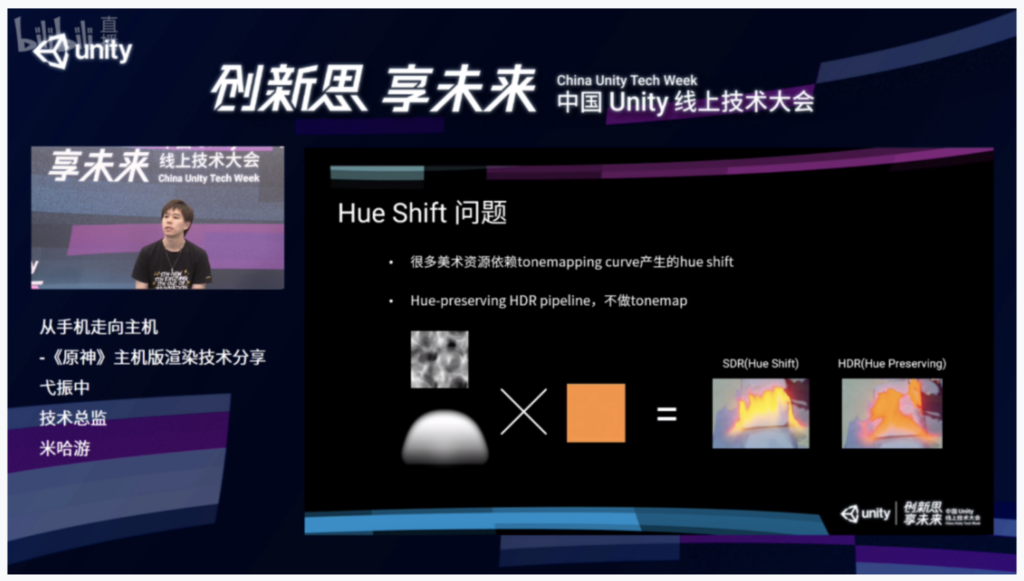
This philosophy essentially resulted in crafting a new kind of rendering pipeline that can adapt to its host platform and thereby deliver the insane game visuals and performance we see in the final product. There was a healthy mix of learning from already established technological frameworks and unique innovation to make the framework fit their specific needs.
In the long run, not only did all this effort make miHoYo $400M richer, but they have now acquired highly valuable cross-platform development skills. And they still have the Xbox and Switch audiences left to capture. That said, it is probably all the new and additive technological knowledge that is miHoYo’s longest term advantage, as it is a strong competitive moat against other gaming studios across the globe.
#3: Doubling Down on Omni-channel Pre-launch Marketing
It is well known by now that GI had a $100M development + marketing budget (though they did not spend it primarily on Google and Facebook). There were two broad strategies that miHoYo uniquely employed to eventually capture ~30M downloads over its first three launch months and the following strong social media stats as of December 2020 -
- YouTube: 1.28M+ subscribers
- Facebook: 900k+ followers
- Discord: 730k+ members
- Twitter: 687k+ followers
- Reddit: 597k+ travelers
- Instagram: 362k+ followers

First, miHoYo completely circumvented Tencent’s ecosystem in China and made a bombshell announcement before the China launch that it would not be available on major Android channels. As MTM’s Owen Soh reported here, close to 90% of ad spend went to Bilibili, Taptap and Bytedance’s platforms, and players can’t even download the game on Tencent’s Myapp store. Not only did this move put miHoYo in the league of meteorically rising smaller, non-Tencent backed studios focusing on slightly niche genres such as Hypergryph (Arknights) and Papergames (Mr Love: Queen’s Choice), but it also helps with accelerating a key tectonic shift within China’s gaming industry borders - sending Tencent a message. Read more here.
Second, GI employed a bunch of omni-channel online and offline pre-launch tactics to garner community interest. GI was able to achieve over 21M pre-registrations, which contributed to fuelling the biggest global launch of any Chinese game in history. To accomplish this, three pre-launch tactics stuck out to us.
Pre-launch Tactic #1: They realized that people would love to share the truly beautiful game experience they created. And they put that realization to work by introducing the game to the world through their first official Youtube video, which came out on June 7th, 2019 - over a year before actual game launch. As you’ll see, it showcases the same beautiful in-game footage and gameplay GI ended up releasing.
Pre-launch Tactic #2: They converted the pre-registration process into a community goal event of sorts by creating a milestone-based incentive system. Through this tactic, miHoYo essentially activated the community to not only work together to maximize pre-registrations volume, but also share GI with as many of their friends as possible. The upside for the community was that all pre-registrants would get the best of the best game start rewards on launch day. Further, and to make this strategy omni-channel, they employed the same incentive structure for garnering social media followers and also through a referral program.

Pre-launch Tactic #3: To further augment organic word of mouth advertising, they also began to run more offline advertising tactics in early September 2020. As can be seen below, GI was all over Japanese busses and trains. This has continued even post-launch and in major Western metropolitan cities like London, Berlin and New York, as can be seen here.
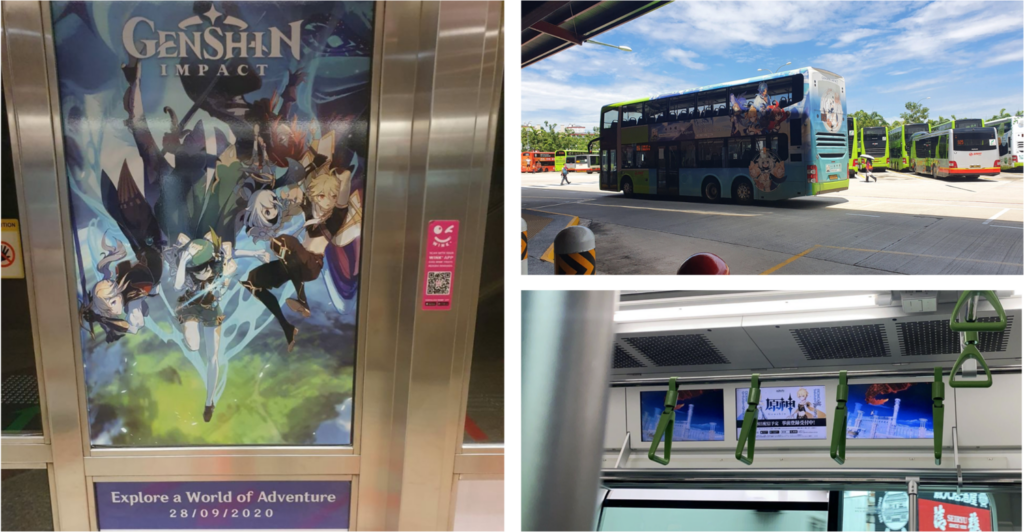
Each of these tactics had clear calls to action to get their total addressable market pumped for the upcoming game launch. These efforts are especially impressive because GI is an original IP, but miHoYo’s strategy has clearly worked!
#4: Identifying the Blue Ocean of a Persistent Open World on Mobile
After the pushing the company to new technological and marketing heights, the last piece was to get audacious about the product vision. We believe the heart of that lay in attempting to build a persistent open world game for mobile. But why open world? Well for starters, our research suggests that GI is probably the first ever persistent open world experience to exist on mobile. And secondly, it is easy to see how attempting to build a game of such great depth and complexity would connect back to miHoYo’s core vision of creating technological marvels with their games.
But why would miHoYo decide to invest a hefty $100M into a kind of game that has likely never been done before? Or was it a measured and validated decision, especially given miHoYo’s track record in first learning and then reinvesting those learnings towards achieving bigger goals? We believe it is the latter, and we hypothesise that the answer lies in HI3.
In HI3, an open world feature unlocks once the player reaches level 18. Apart from that being mind-blowing in itself for anyone familiar with the depth of HI3, it was interesting to note that this open world feature was rolled out as an open beta in HI3 in April 2017, which is just three months merely after the concept of GI was conceived in January 2017. In other words, we believe it was done as a technical and product prototype to validate an open world experience working for the mobile audience, which is also probably why it was an open beta launch.
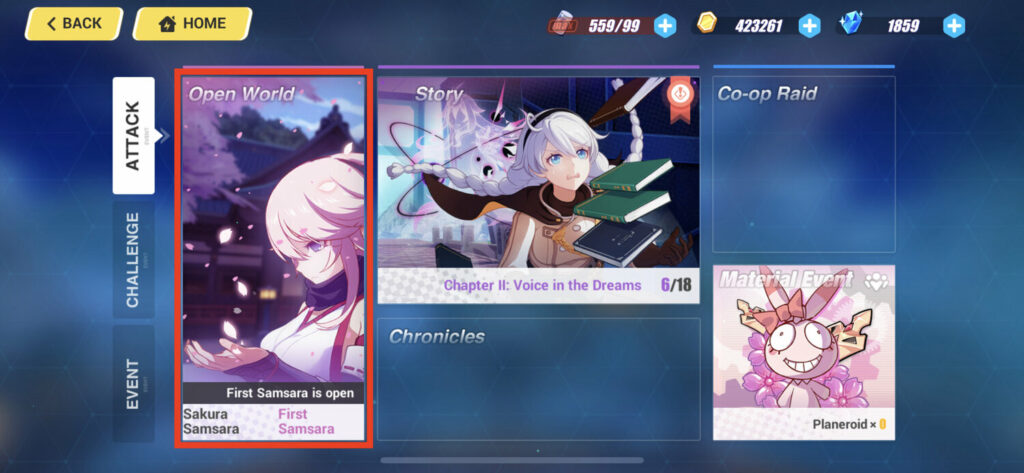
It should be mentioned though that HI3’s open world is not quite open world, given its highly guided and on-the-rails experience. It is also nowhere close to GI’s open world experience in terms of graphical rendering. But one can see the beginnings of an open world technical foundation and product thinking within that feature. If you play HI3’s open world after playing GI, we guarantee you’ll see the similarities.
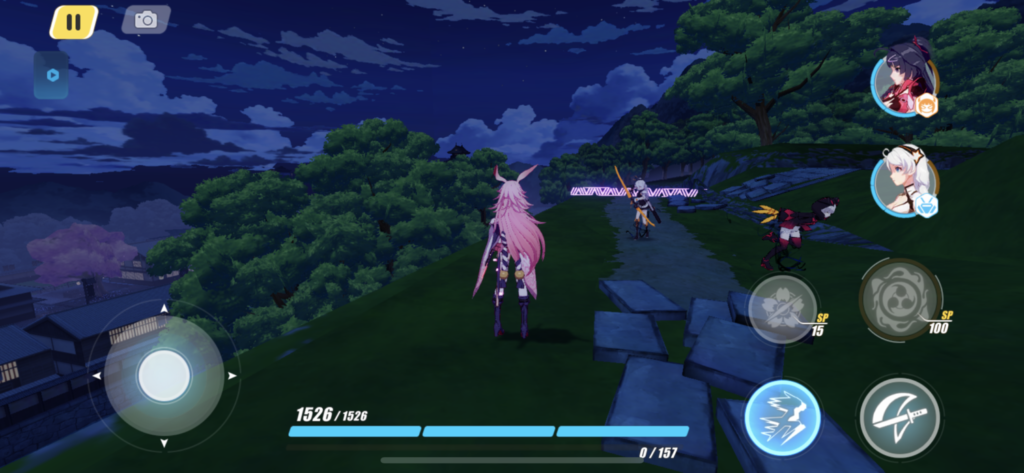
If this feature essentially locked in the technical and product validations, there was one last part of the project validation equation left unsolved - proving a large enough revenue potential that could justify a $100M project investment. Luckily for miHoYo, HI3’s open world feature led to the highest revenue spike of the game’s lifetime until that point. Further, the revenue graph below also indicates a massive baseline revenue shift after the feature went live. We believe this brilliant revenue result of HI3’s open world feature was exactly the validation that miHoYo was looking for to continue their efforts in building GI. And the cherry on the cake was quite a lucrative open beta feature launch.

Given all the above, it is clear that miHoYo has been very audacious with its technological, marketing and product visions with GI. And this audacity is at the core of why GI marks the start of a new inflection point for mobile games. What GI has been able to accomplish here is really set the precedent for the industry on multiple fronts. miHoYo not only shows the entire game development community that through technological innovation, recreating a console-like gaming experience is possible on mobile. They also signal that there is a new generation of Chinese game developers brewing, who are poised to create compelling original IP gaming experiences for both Eastern and Western audiences. And finally, this game is a strong signal that many traditional AAA experiences are well on their way to becoming free-to-play in the future. We discuss each of these points in the final section of the essay.
Though at the end of the day, what really matters in free-to-play is whether the game can sustain itself long-term. Delivering a truly open world gaming experience on the backbone of a free-to-play business model is no easy task. So from a long-term sustainability perspective, did GI’s audacious vision make miHoYo fly too close to the sun?
GI Mixes Oil and Water
Yes, GI is beautiful. Yes, GI has grossed $400M in 3 months. And yes, GI is wildly successful. There is no denying those facts. But all these facts are based on 3 months of launch data, the scale of which was also driven by miHoYo’s massive pre-launch marketing efforts. Clearly, GI’s early game experience (including content, systems and balancing) leaves a strong mark on anyone who plays it, and it is definitely driving the massive revenue numbers on a mere 25M downloads.
At the same time, is GI built for maximum long-term revenue potential? Some worry that GI’s high production values will slow down the content treadmill miHoYo needs to keep this game running. But if HI3’s revenue curve tells us anything, it is that producing content for a high production quality game will likely not be an issue for miHoYo - they’ve done it before. And don’t forget, GI has a 300+ person development team, which has likely grown further. We see deeper design issues with the game that can compromise product longevity.
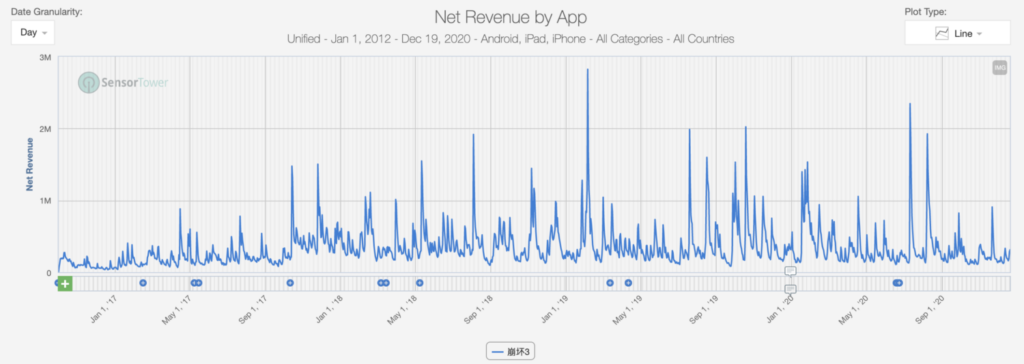
It is quite obvious that GI is attempting to be both an open world experience and an action RPG. Therefore, the game has two very strong vectors to drive long term player retention - world exploration and character progression. Though while performing this design analysis, it became increasingly clear that GI’s take on fusing typical action RPG free-to-play mechanics with an open world experience ends up looking like mixing oil and water. As a result, the game is heavily focussed on maximising the character progression vector, but ends up losing the opportunity to deliver on a truly open world experience, in which world exploration could have been maximized as a long-term retention driver.
This means that GI, in its current state, will likely burn down to its core super-fan audience and end up relying on them for long-term revenue much faster than is necessary. In other words, the long-term design implications of fusing such distinct experiences could’ve been better thought through. And while GI has already seen massive revenue success, we feel the ceiling could’ve been much higher. Let’s break that down a bit.

GI does not make 1 + 1 = 3
Classical open world RPGs are built on a tight synchronisation between three core design pillars - narrative, exploration, and progression. As seen in the image below, ideally there is a healthy give-and-take relationship between each of the design pillars, which results in a highly synergistic gameplay experience that can be perpetually fun for players. In other words, the more a player plays, the more each of these design pillars scale with synchronicity -
- The more the world is explored…
- The more of the narrative is unraveled…
- The more the player buys into his role in the world…
- The more the need for the player to level up to keep up with the world, and the loop goes on.
When done properly, this can be a very powerful loop that drives perpetual fun and sustains the long-term player experience.
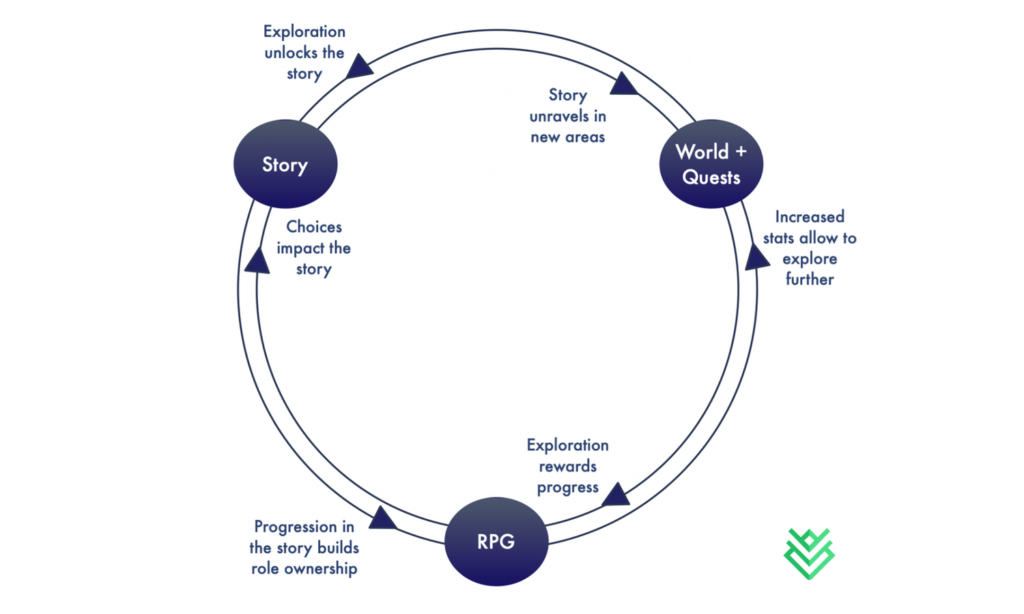
Funnily enough, most free-to-play action RPGs of today also rest on the same three core design pillars, but add to the mix a gacha (loot box) system to monetise all that perpetual fun. The way HI3 makes this a highly synergistic gameplay experience is captured in the image below. To summarise it -
- The more a player completes linear mission content, the more narrative and rewards he unlocks, and the more linear content there is to play.
- To monetise that, the difficulty of linear mission content scales over time, which incentivises the player to upgrade his character and weapon rosters through progression systems that need a lot of resources to make progression happen.
- At this point, the player could choose to grind through a ton of content to win enough resources to reinvest into the game’s character/weapon progression systems, or he could choose to invest in the game’s gacha systems to boost his progression speed. Basically, pay or play.
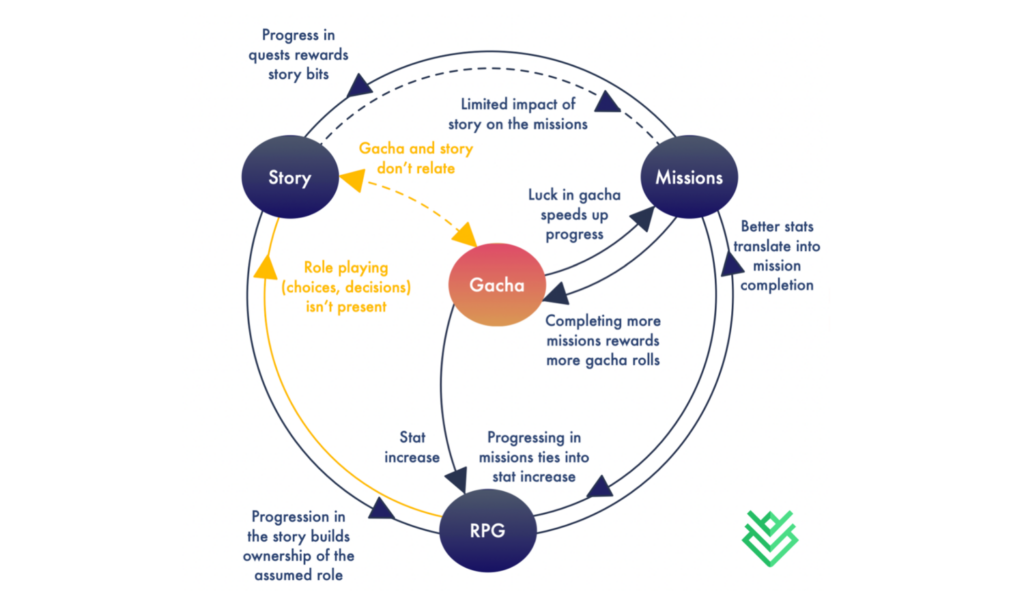
Now anybody familiar with HI3 will be able to instantly notice that GI’s character progression and gacha monetisation mechanics are heavily inspired from HI3’s system design. And given miHoYo’s proven track record in reinvesting learnings from previous games into future games, it definitely feels like miHoYo simply picked up and dropped HI3’s proven systems into GI’s open world context. Unfortunately, miHoYo has not been able to make 1 plus 1 equal 3, and there are two major reasons why.
#1: Linear Progression in a Non-linear Open World Makes Exploration Meaningless
While reinvesting learnings is a good practice in general for any game development studio, forgetting to reshape the implementation of those learnings to fit new contexts will usually work against maximising product longevity and long-term revenue potential. This is the first problem with GI’s open world experience.
As mentioned before, it feels like miHoYo has reimplemented many of HI3’s systems within GI. But HI3’s progression and monetisation systems were built to realise an Action RPG product vision, not an Open World Action RPG one. A stripped down version of the game’s progression essentially translates to character and equipment collection/levelling growing linearly through a mission based system, both of which are driven by the gacha odds. Said differently, HI3’s systems are designed to fuel highly linear content progression, but GI’s content lives in an open world that the player moves through at their own will (aka highly non-linearly).
GI reimplements HI3’s linear mission systems through its Dungeon mechanic. Players deep into GI are quick to realise that Dungeons are a highly valuable source of rare character progression materials. Further, and like HI3’s missions, Dungeons scale in difficulty. This ends up creating the following loop - to continue progression, the player needs items to ascend characters/weapons, and to satisfy that need he interacts with Dungeons of increasing difficulty, plus grind the gacha. All good until this point.
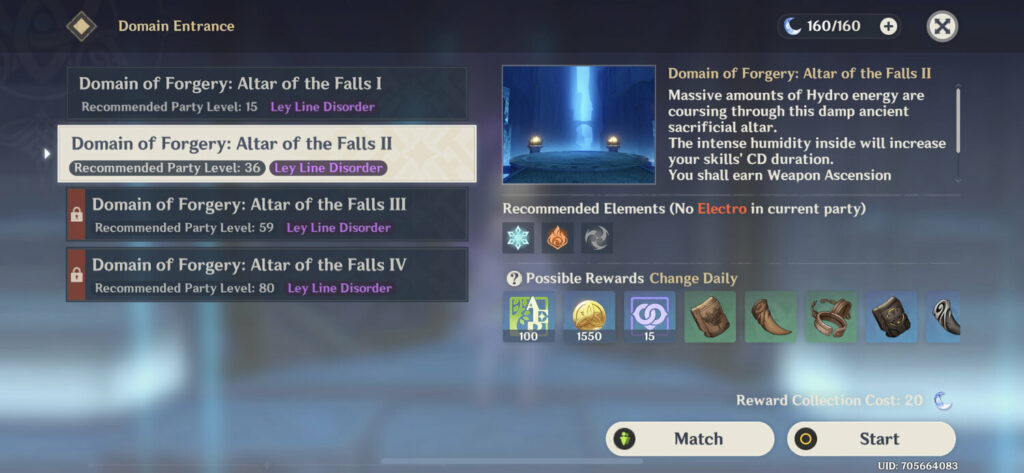
However, the more valuable Dungeons are made to drive long-term character progression, the more important it is to ensure world exploration remains a worthwhile endeavour. If it’s not worthwhile, the game experience is reduced to a simple grind of locating Dungeons, using the Waypoints to quickly get there, winning the Dungeon rewards, and utilising those to drive character progression. In other words, the game increasingly becomes only about character progression and world exploration plays second fiddle.
Players don’t recognize this issue immediately since the initial gameplay experience is fun and new. In the early game, various items that players need to level up their characters/weapons are plentiful. But as the game’s balancing introduces larger and larger gaps between each character/weapon progression level — all of which rely on the same items to level up but in larger amounts — it leads to a highly repetitive, tedious and monotonous long-term player experience.
Furthermore, GI uses an energy gating mechanic called Resin that paces the Dungeon rewards and shapes the player session into a checklist of Dungeons to grind. To a well-versed free-to-play player, this mechanic suggests that once they run out of Resin, the session is over. That directly goes against maximising the motivation to explore. But what if Resin dropped randomly while exploring the open world? That would help create a healthy meta-to-core loop interaction, where interacting with the meta prolongs interaction with the core. Of course the gameplay experience would largely differ, but it would also be a step towards incentivising the player to explore the world.
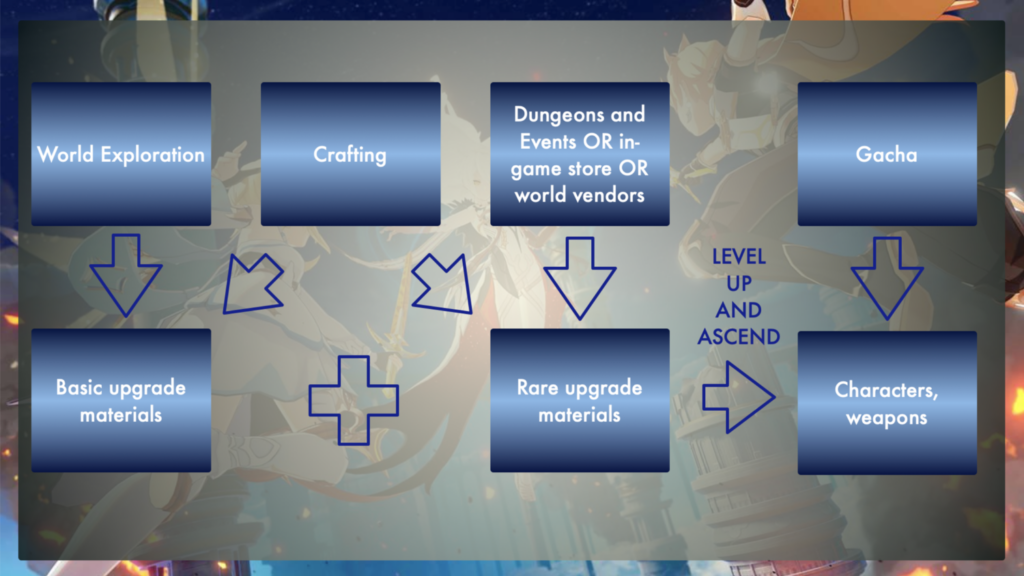
GI reimplementing HI3’s linear progression systems in an open world context without thinking through the long-term design implications makes GI face a major identity issue. The game is reduced to a strong Action RPG experience but a very weak Open World one - not the other way around, as it was likely intended. This identity crisis creates a ton of friction in the game’s core progression loop and is eventually detrimental to the long term player experience. While the image below highlights these key points of friction, the key takeaway is simply that dropping HI3’s progression and monetisation systems into an open world is not game design at its best.
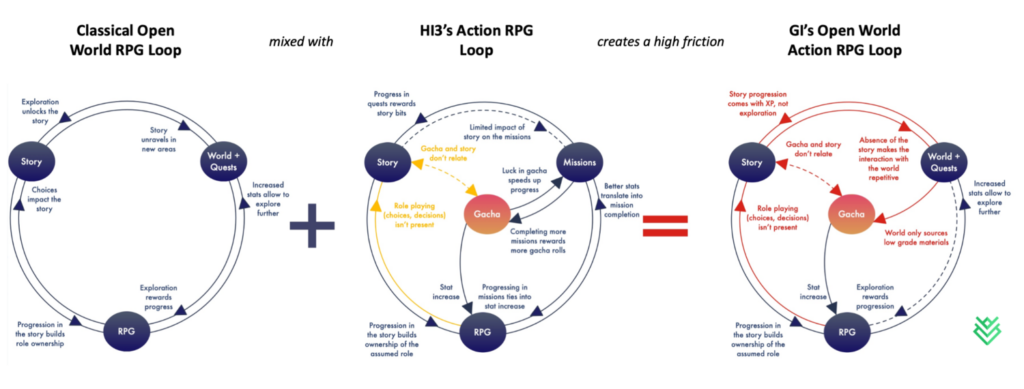
It would be ideal for GI to utilise the expanse of its open world to drive both exploration and character progression as long-term retention vectors. The way to make that happen would involve making the act of journeying through the open world meaningfully contribute to the game’s core progression loops. Unfortunately, and as illustrated in the image above, GI is unable to give meaningful rewards from the world because that would devalue the gacha, which reduces the world to a source of meaningless materials and undermines world exploration as a long-term retention driver. We couldn’t find examples of free-to-play open world game’s that are able to pull this off, but that is also partially because GI is likely the first of its kind. That said, we do believe there is a path toward having a gacha grind co-exist with an open world experience.
#2: GI Doesn’t Drive Exploration the Way Zelda Does
For an open world action RPG (whether premium or free-to-play) to truly maximise exploration as a long-term retention vector, the game needs to deliver on three aspects -
- Make the player’s impact on the world tangible
- Make the world react to player actions in interesting ways
- Make the world vast enough to foreshadow tons of content
While the first two points create a strong interactive relationship between the player and the world, the third helps elongate the freshness of this interactive relationship over a longer period of time. Delivering on all three helps spark many questions in the player’s head, such as “what’s next in the story” or “how do I get to the top of that peak” or “how do I use the world to beat this monster”, and therefore creates a strong intrinsic curiosity and motivation to explore the world. And of course, the more the player explores, the more the player progresses.
At this point, it makes sense to compare “Legend of Zelda: Breath of the Wild’s” (BoTW) open world experience to that of GI’s for a few reasons. GI’s world is unmistakably inspired from BoTW’s. Further, many of GI’s exploration mechanics are quite similar to those of BoTW’s, such as climbing and gliding. And finally, the massive controversy around how GI is just a mobile rip-off of BoTW deserves the comparison. Though the more we played GI, the more we realised that while GI’s early game experience might throw up these three similarities, GI’s implementation of them unfortunately turns out to be a case of one man’s meat being another man’s poison. There are three core reasons why.
First, BoTW’s open world experience results in a multiplicative gameplay experience vs an additive one. In other words, BoTW prioritises the creation and maintenance of the previously mentioned interactive relationship between the player and the world. This is primarily done so that the world doesn’t feel like a place filled with pre-determined event sequences, but rather one that can be explored and progressed through in a non-linear way with no downside to the player. Further, it also helps with increasing content reusability and Nintendo does not need to create tons of new content to keep BoTW’s vast world interesting.
In this wonderful GDC talk, Nintendo explains how they achieve this. However, in a nutshell it boils down to their Physics and Chemistry engines. Through its physics engine, BoTW allows the player to interact with world objects to drive exploration and progression. Further, world objects also interact with each other to mirror an almost real world experience. For example, a player can cut a tree in BoTW, and if the log falls in water, it floats. The player can then jump on that floating log to continue his journey through the world. And through its chemistry engine, BoTW creates the opportunity for players to use elements like fire, water, wind and electricity to interact with the world in a completely new way to make all that exploration and progression highly interesting. For example, if the player is standing on that floating log and an enemy jumps onto it, the player can light the entire log on fire and thereby also kill the enemy.
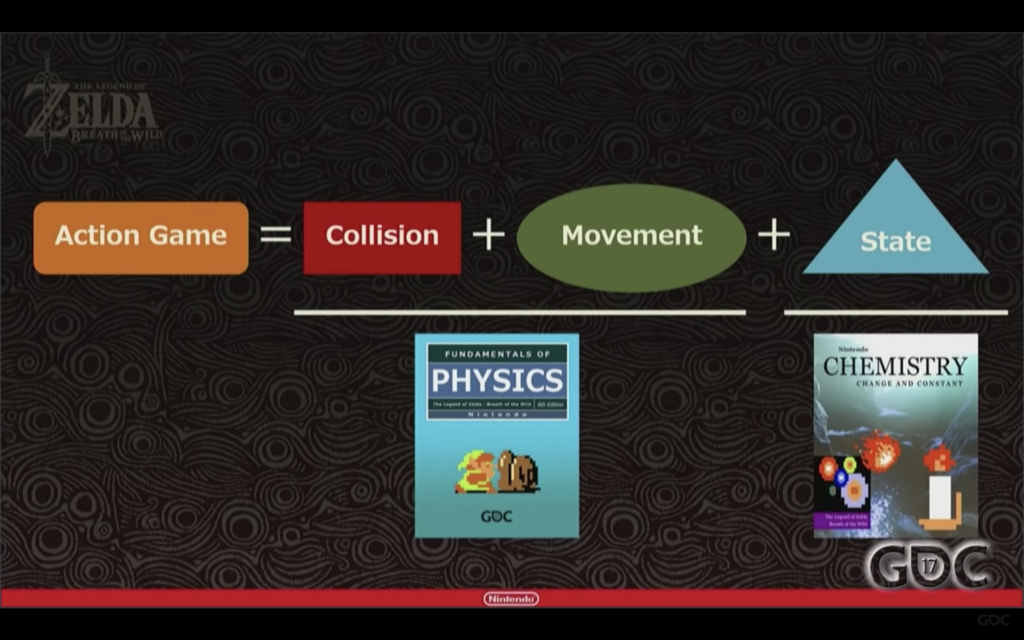
Yes, GI does have hints of this too, such as Cryo characters being able to freeze water/enemies or Pyro characters being able to light a fire for cooking. The most notable implementation would likely be the inter-character elemental reactions during combat. But none of this contributes to building that strong interactive relationship between the player and the world. It is possible that miHoYo has realised this gap in experience because GI is introducing brand new environmental mechanics like climate change affecting the player state in their upcoming 1.2 update. But this mechanic is only limited to the new Dragonspire area which is being released in the same update. So while it is a small step in the right direction, it likely doesn’t solve the problem across the entire open world experience.
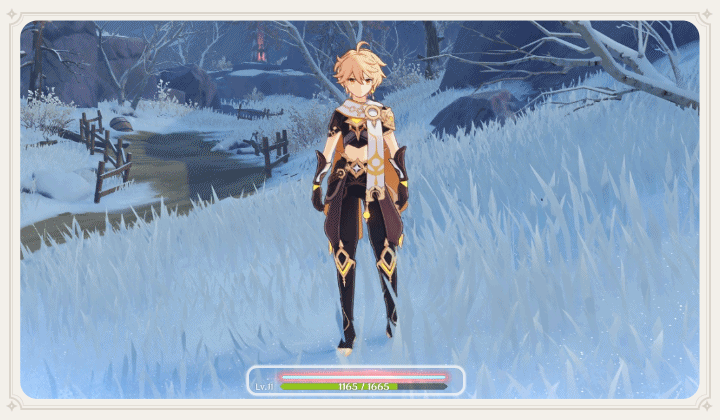
Second, BoTW uses the size of its world to its advantage and makes sure the players feel and celebrate its vastness. To illustrate this with an example - in BoTW, Shrines not only work as fast travel points, but also are puzzling experiences in terms of being discovered and completed. Therefore, they eventually end up serving as counts of achievement and bragging rights where players tell their friends about how many they completed. There are an enormous number of them, and exploring the world to find and complete them is a major mechanic that makes the player stronger and more equipped to progress. It’s a full loop that drives both the exploration and progression long-term retention vectors, quite beautifully packaged within a single mechanic.

On the other hand, GI splits this mechanic of exploration and puzzle solving into two, and unfortunately doesn’t deliver on either. First, the Waypoints are instantly shown on the map once the associated Statue of Seven has been unlocked. This ends up killing the need to explore the world to find these Waypoints, and therefore an opportunity is lost to challenge players to discover them. Second, unlocking Waypoints involves no puzzle solving - just get there and hit unlock. The puzzle solving instead lives in the journey to the Waypoints, through mechanics like spirits that are hidden in GI’s landscape. The level design of these puzzles is solid and adds one of the few flavors that build innate curiosity, but it unfortunately doesn’t come with the sense of visual achievement that would make for a fully flavoured progression mechanic.
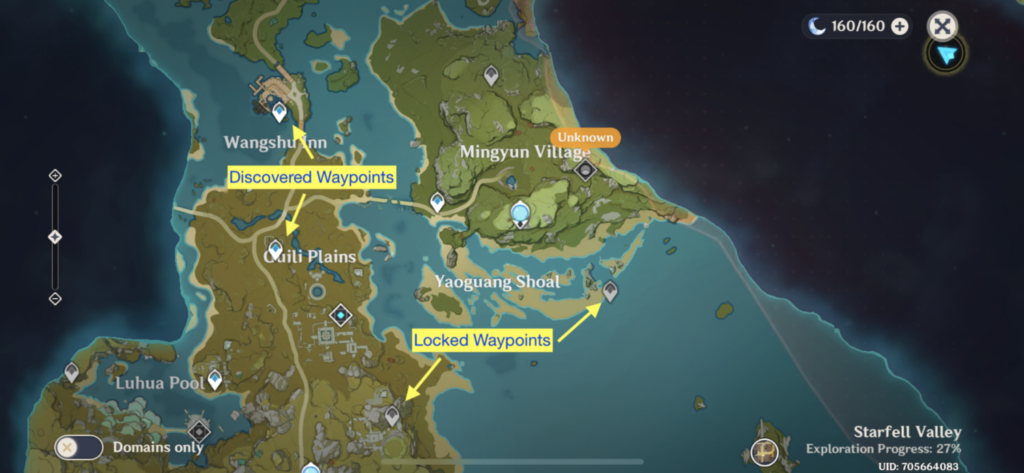
Third, BoTW’s narrative progression facilitates non-linear world exploration and progression very well. In BoTW, where the player is and what they do is not relevant to its narrative progression. The player still learns about what happened 100 years ago, they can choose to care or not, but the world will make sure remind them that they should. More specifically, there is a huge castle in the middle of the map, surrounded by a menacing purple fog, that the player can see from many high top points. Ganon’s Curse is ever present and woven into the landscape to always remind the player what they need to achieve, no matter how much they lose themselves in exploration. All of this small, smart and strong ways to make the world of Hyrule feel vast and foreshadow tons of content, thereby driving both exploration and progression.
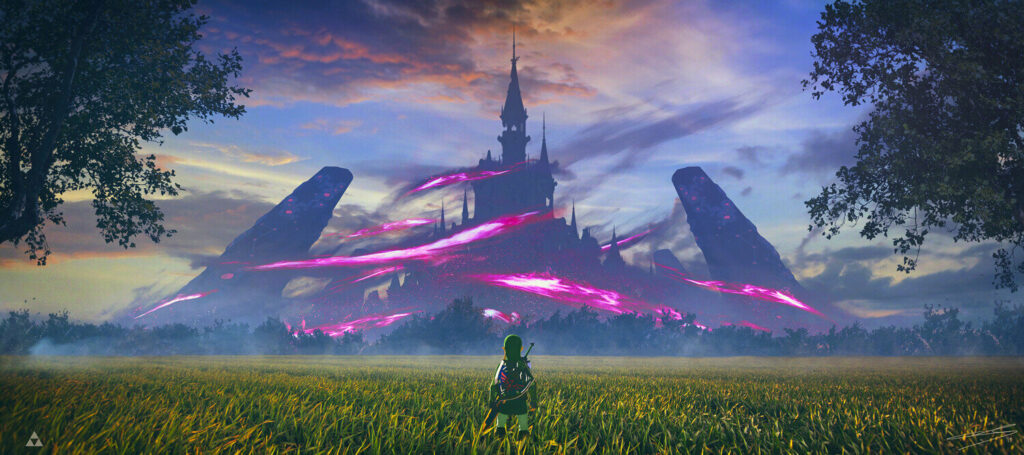
GI’s story tries to build a similar longing for something that was lost through its initial narrative experience of the player losing his/her sibling, but it is quickly decoupled from player’s main activities. For example, neither do the daily missions nor the interactions with various world NPCs connect back to GI’s core storyline. There is a specific quest line for unraveling the game’s story, which is just a way to box away the game’s larger narrative experience. And that just ends up making GI’s world feel like a very disconnected experience between regions, and ends up diluting the longer term narrative goal the player started the game with - finding his/her long lost sibling!
There is one major contradiction, though, in this narrative comparison to BoTW - GI’s world is supposed to be an endless free-to-play experience, while that is not the case for BoTW. In other words, a world that needs to host endless grind and random encounters isn’t a world that can hold a finite story and permanent changes. It does showcase how hard it is to introduce forever meaningful narratives in an open world experience, especially one that runs on a free-to-play business model. In GI’s case, it would have been probably smarter to introduce an endless conflict between two opposite sides and continuously resurface it to players throughout their world exploration and progression experience. This would enable the developers to build an endless variety of events around a vast, central struggle to keep players motivated over the long-term.

It may seem unfair to compare GI to BoTW. We could point at many games and explain why they don’t match up to the masterpiece that BoTW undoubtedly is. In GI’s case, however, it makes sense to point out that building a meaningful open world is no small feat, and if you’re going to have an open world, then why not use its full potential. There are subtle yet important mechanics that can help maximise the long-term retention drivers of exploration and progression, and they could’ve done better than take HI3’s progression system and place it in GI. We still believe it is not too late for miHoYo and GI to evolve, and they can still use their existing product and technology to solve the issues called out above. Even better, they now have the budget for it.
GI Showcases the Exciting Future for Mobile
Even though GI suffers from some fundamental design issues, miHoYo’s achievement with GI should be celebrated, and it’s going to push mobile games to the next frontier. More specifically, GI marks an inflection point for three key mobile gaming trends -
- GI shows the entire game development community that through technological innovation, recreating console-like gaming experiences is possible on mobile.
- There is a new generation of Chinese game developers brewing, who are poised to create compelling gaming experiences for both Eastern and Western audiences.
- Traditional AAA experiences will be increasingly free-to-play in the future.
First, it is important to double underline that miHoYo’s success with GI as a cross-platform, console-like game experience should serve as a wake up call to big western game developers and publishers. It is now possible for mobile to host vast and high quality experiences, mobile gaming production and consumption are more global than ever before, and the mobile market opportunity is simply massive! Though the product issues that GI suffers from only goes to show the mammoth task it really is to pull this off.
Second, China has truly become a powerful force to be reckoned with in game development. What started as work for hire / outsourcing studios has blossomed into full fledged game development studios capable of creating AAA quality games that resonate with both Eastern and Western audiences. And if GI’s audacious marketing activities tell us anything, it is that this these studios are extremely well funded and able to pull off massive scale with original IP. Said differently, there is a new generation of Chinese game developers brewing, who are poised to create compelling gaming experiences for global audiences. This trend has been growing slowly over the past couple years, and it can be clearly seen in the graph below.

How has the Chinese game development community been able to grow in this way? A large part of this comes from their unquestionably diligent work ethic where 996 is the standard work week in Chinese game studios. “996” means working from 9 am to 9 pm 6 days a week. It should be noted that this is not an enforcement, but rather an unofficial norm. Further, and as MTM’s Owen Soh tells us, this nonstop attitude is also fuelled by a big difference in pay structures compared to that of Western game developers. In China, one is paid like an investment banker if their game succeeds and it’s quite common to implement profit share mechanics. Naturally, some will skip sleep for the big pay day. Here is a job description that mentions a 4% profit share upfront. There aren’t too many articles that cover this specific topic, which would also make sense given that entrepreneurs would likely want to not get very public about employee profit share numbers they maintain. But you can read some more about this topic here and here.
With this kind of consistency and persistence, smart and visionary minds behind all that hard work, and a pinch of passion, it is no surprise that we’re seen multiple top grossing hits come from Chinese game developers in the past couple years. “AFK Arena” from Lilith Games is the gold standard when it comes to Idle RPGs. “Rise of Kingdoms” (also from Lilith Games) helped evolve what a 4X game is today. “Matchington Mansion” from Firecraft Studios surprised the entire Puzzle market by being able to compete with the likes of Playrix’s “Homescapes” and “Gardenscapes”. “Archero” from Habby showed the industry how to evolve hypercasual to its next stage - hybridcasual. And finally, “Arknights” from Hypergryph was a breakout hit while massively refreshing the tower defense RPG sub-genre. Not only are all these games top grossing titles in the west, but some can also be called genre-defining. More importantly, western developers now seem to be learning from these China-developed games and rewriting mobile F2P game design best practices. In a nutshell, China is turning the tables on the west.

All that said, we prefer not to look at GI as marking the start of a competition between Eastern and Western developers. Rather and third, we see GI marking the beginnings of both Eastern and Western game developers publishing visually stunning, experientially satisfying, and technology defying gaming masterpieces across all platforms and for free. Whether GI continues to see such success for months and years is yet to be seen, but we do think that this will cause AAA console and PC players to finally consider what they could do on mobile. We’ve seen Ubisoft, Activision, Take-Two and others all dip their toes into mobile, but we’ve yet to see a game with the quality, size or scale of Skyrim or Grand Theft Auto make it’s way to mobile. Will GI show these large players that there is significant upside available to them if they can take their skills and apply them to mobile? The most recent example of this shift being underway is of course Activision Blizzard’s Diablo: Immortal just dropping in Australia for its technical alpha. Read our take on how to transition a PC/Console focussed business to mobile.
To end things on a forward looking note, we’d leave you with this. It’s time to hold on to your seats because traditional AAA is going free-to-play, you will be able to carry it around in your pocket, and we cannot wait!





